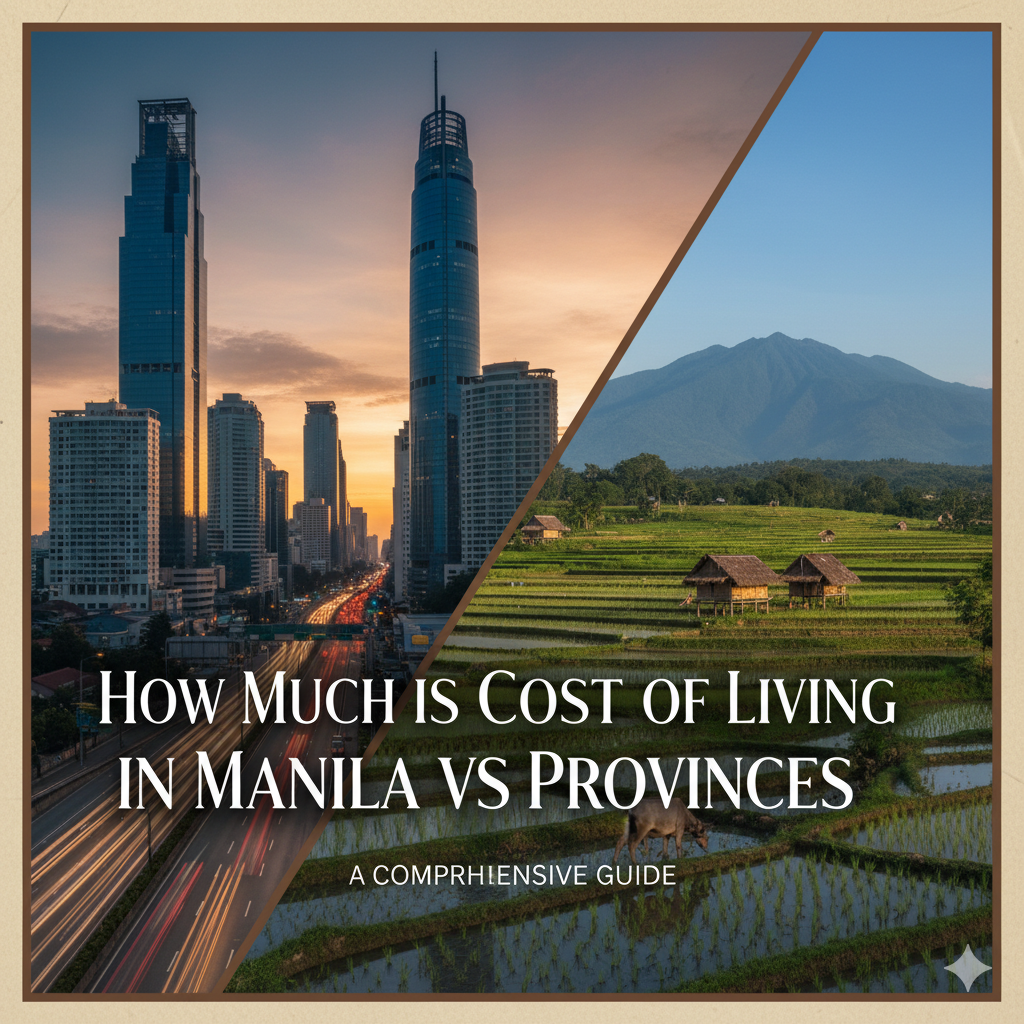Comparing living costs: Manila vs Philippine provinces — clear, quick, and practical
If you’ve ever asked how much is cost of living in Manila vs provinces, you’re not alone — many Filipinos, expats and remote workers want a simple, realistic answer before they move or choose a work location.
In this article we’ll cut through headlines and show the typical monthly differences (rent, groceries, transport, utilities, and income), explain why some provinces can be surprisingly costly, and give sample budgets you can adapt.
By the end you’ll have a practical sense of whether Manila’s price tag fits your lifestyle — and when a provincial move actually saves money.
TL;DR — the short answer
-
Manila (Metro Manila) generally has higher rents and more expensive lifestyle options, especially in central business districts.
-
Day-to-day essentials (food, transport) can be cheaper outside Metro Manila, but nearby urbanized provinces (e.g., Cavite, Laguna, Rizal) sometimes match or exceed Metro Manila on certain items like housing and grocery prices. Pacific Prime+1
What costs the most (and where the gaps are)
1) Housing — biggest single gap
Expect rent to be the largest driver of difference. A one-bedroom in central Manila commonly ranges PHP 25,000–45,000/month; comparable units in many provincial cities are often PHP 10,000–20,000/month — but suburbs and nearby provinces can be higher. Use these figures as a working rule for planning. Pacific Prime
2) Food & groceries
Basic groceries and market prices are broadly similar nationwide, though eating out in Manila’s commercial districts or malls costs more. Local wet markets and provincial eateries typically stretch a budget further.
3) Transport
If you rely on public transit, Manila’s network can be cheaper per trip but the frequency of trips and congestion often increase monthly transport spending. Provinces where you need to own/use a car or frequent intercity travel may see higher transport costs.
4) Utilities & internet
Electricity and internet plans vary but are generally comparable; however, reliance on air-conditioning in cities can spike electric bills in Manila’s apartments. Broadband packages in major provincial cities are increasingly competitive.
5) Healthcare & education
Private hospitals and international schools (if needed) are more concentrated and pricier in Metro Manila. Provincial options exist but specialized care often requires travel to Manila — factor that into yearly budgets.
Income context — how much can you earn?
The Philippine Statistics Authority reports average family income and spending trends that show income growth but continued variation by region. National averages are helpful to set expectations: salaries in Metro Manila are typically higher, which offsets part of the higher costs, but savings potential depends on lifestyle choices. Philippine Statistics Authority
Surprising twist: some provinces cost more
Not all provinces are cheaper. Urbanized, fast-growing provinces near Metro Manila (e.g., Cavite, parts of Laguna and Rizal) have seen rapid housing demand and price jumps — in some cases overtaking Metro Manila neighborhoods on specific cost measures. That’s why saying simply “provinces are cheaper” can be misleading. Philstar
Example monthly budgets (estimates, exclude one-off costs)
-
Single person — central Manila (modest lifestyle, excluding rent): ~PHP 30k–45k (food, transport, utilities). Numbeo
-
Single person — provincial capital (modest): ~PHP 18k–30k (same categories).
-
Family of four — Metro Manila (modest, excluding rent): ~PHP 100k+; provinces often 30–50% lower depending on location and housing. Numbeo+1
(Numbers above use published cost-of-living estimates and market rent ranges as a guide — adapt to your desired comfort level.)
Practical tips to lower your cost no matter where you live
-
Choose neighborhoods near your work to cut commute time and transport spend.
-
Shop at local markets and cook at home — biggest savings on food.
-
Consider co-living or shared housing in Manila; consider smaller condos near provincial business centers.
-
For remote workers: weigh higher Manila income (if applicable) vs. lower provincial costs — remote income often makes living outside Metro Manila highly attractive.
FAQs
Q: How much is cost of living in Manila vs provinces — quick answer?
A: On average, living in Metro Manila costs more mainly because rent and certain services are pricier. But the gap varies — expect housing to be 1.5–3× more expensive in central Manila than in many provincial cities; nearby urbanized provinces may be similar or higher for housing. Use local rent listings and cost calculators to get exact figures for the city you’re comparing. Pacific Prime+1
Q: Will moving to the provinces always save me money?
A: Not always. Savings depend on housing choice, commute needs, and whether you still need frequent Manila trips for work or healthcare.
Q: Where do expats find the best balance of cost and services?
A: Cities like Cebu and Davao offer strong services at lower housing costs than central Manila — but pick neighborhoods close to amenities to avoid hidden transport costs. Expatistan, cost of living comparisons
How to use this guide (quick checklist)
-
List your non-negotiables (school, hospital access, commute).
-
Compare 3 neighborhoods in Manila vs 3 provincial cities using rent + grocery + transport.
-
Add one-off yearly costs (plane trips, vehicle maintenance) to monthly totals.
-
Use PSA or cost-of-living sites (Numbeo/Expatistan) for baseline numbers, then adjust for your lifestyle. Philippine Statistics Authority+2Numbeo+2
Conclusion
If you’re wondering how much is cost of living in Manila vs provinces, the core truth is this: Manila tends to cost more mainly because of rent and lifestyle options, but not every province is cheaper — proximity to Metro Manila, local development, and housing choices matter. When you compare neighborhoods side-by-side and include transport, healthcare and income differences, you’ll get a clear, realistic budget. So ask local landlords about actual rent, check updated cost indexes, and run two 6-month sample budgets (Manila vs chosen province) before you decide — that’s the best way to see whether moving will really save you money. How much is cost of living in Manila vs provinces comes down to your housing choice, commute habits and income — plan those three and you’ll know fast. How much is cost of living in Manila vs provinces — short answer: usually more in Manila, but exceptions are common; verify for the exact cities you’re comparing.
Sources & further reading (key references): Numbeo (city cost estimates), Expatistan, PacificPrime housing guide, Philippine Statistics Authority family income reports, Philstar coverage on provincial price trends. Philstar+4Numbeo+4


